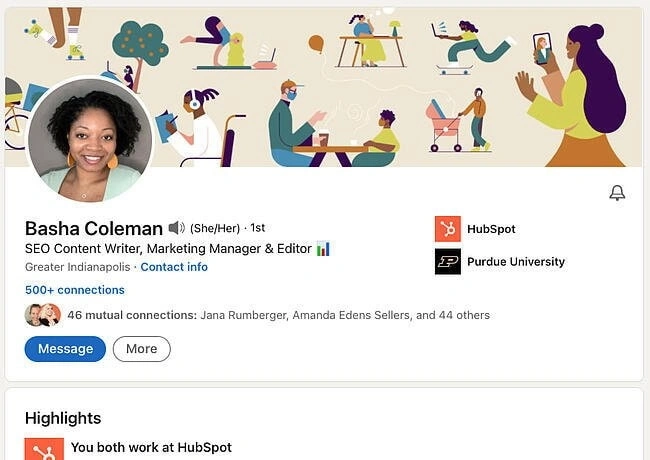LinkedIn, the world’s largest professional networking platform, has become an essential tool for professionals looking to advance their careers and connect with like-minded individuals in their respective industries.
With over 756 million members across 200 countries, having a strong LinkedIn profile is crucial for establishing your online presence, expanding your network, and attracting potential job opportunities.
In this article, we will explore the various elements and strategies involved in building a compelling LinkedIn profile that stands out from the crowd and helps you achieve your professional goals.
Understanding the Importance of a LinkedIn Profile

Before diving into the key components of a strong LinkedIn profile, it is crucial to grasp the significance of this platform in the realm of professional networking. LinkedIn serves as a virtual resume and a professional portfolio, allowing individuals to showcase their skills, experiences, and expertise to a global audience.
In today’s digital age, where networking and personal branding play a pivotal role, LinkedIn provides a powerful platform to connect with industry professionals, employers, and potential clients.
LinkedIn has revolutionized the way professionals connect, enabling users to build a network of connections beyond geographical boundaries. By connecting with colleagues, former classmates, mentors, and industry leaders, you can tap into a vast network of professionals who can offer insights, recommendations, and potential job opportunities.
According to a recent survey, 85% of hiring managers and recruiters use LinkedIn to search for and vet candidates for job openings, highlighting the platform’s significance in today’s job market. Moreover, LinkedIn allows professionals to join industry-specific groups and engage in discussions, expanding their knowledge and showcasing their expertise to a wider audience.
With the majority of employers and potential clients using search engines to research candidates and professionals, having a strong online presence has never been more important. A well-crafted LinkedIn profile can help you establish a positive online reputation, increase your visibility when job searching, and enhance your credibility in your industry.
When you optimize your profile with industry-specific keywords and phrases, you increase your chances of appearing higher in search engine results. This means that when a potential employer or client searches for professionals in your field, your name and profile will be among the top results, making it easier for them to discover and connect with you.
But a strong LinkedIn profile is not just about keywords and search engine rankings. It is also about presenting yourself in a compelling and authentic way. Your profile should tell a story about your professional journey, highlighting your achievements, skills, and experiences. It should showcase your unique value proposition and demonstrate why you are the ideal candidate or professional for a particular role or project.
One effective way to enhance your LinkedIn profile is by including rich media content. You can upload videos, presentations, and samples of your work to provide a more comprehensive view of your capabilities. This not only adds visual interest to your profile but also allows potential employers and clients to see your skills in action.
Another important aspect of a strong LinkedIn profile is engaging with others. This means actively participating in discussions, sharing relevant content, and commenting on other people’s posts. By doing so, you not only demonstrate your expertise and knowledge but also build relationships and expand your network.
Furthermore, LinkedIn offers the opportunity to receive endorsements and recommendations from colleagues, clients, and mentors. These endorsements and recommendations serve as social proof, validating your skills and expertise. They can significantly enhance your credibility and make you stand out from the competition.
A strong LinkedIn profile is essential for professionals in today’s digital age. It not only helps you connect with industry professionals, employers, and potential clients but also enhances your online presence and credibility. By optimizing your profile, engaging with others, and showcasing your achievements, you can maximize the benefits of this powerful platform and take your professional networking to new heights.
Essential Elements of a Strong LinkedIn Account

Now that we understand the significance of LinkedIn in professional networking and online presence, let’s delve into the essential elements that make up a strong LinkedIn profile.
LinkedIn has become the go-to platform for professionals looking to connect, network, and showcase their skills and experiences. With millions of users worldwide, it’s crucial to have a compelling and well-optimized profile that stands out from the crowd.
Crafting a Compelling LinkedIn Headlines
Your LinkedIn headline is the first thing users see when they come across your company pages or your profile. It should be concise, attention-grabbing, and highlight your area of expertise or unique selling proposition.
Instead of using generic terms such as “Experienced Professional,” try personalizing your headline with specific skills or achievements that set you apart from the competition. This will instantly capture the attention of potential employers or clients and make them want to learn more about you.
For example, instead of the job title “Experienced Marketing Professional,” a more compelling headline could be “Digital Marketing Strategist | Helping Businesses Increase Online Visibility & Drive Revenue.” This headline not only showcases your expertise but also conveys the value you can bring to organizations.
Writing a Professional Summary
Your LinkedIn summary is an opportunity to showcase your professional journey, achievements, and goals. While brevity is key, aim to provide a compelling overview of your skills, experiences, and areas of expertise.
Utilize bullet points, paragraphs, and spacing to make your summary easily scannable. It’s essential to communicate your value proposition and unique selling points in a concise yet compelling manner while keeping your target audience in mind.
Consider including specific examples of projects you’ve worked on, results you’ve achieved, or challenges you’ve overcome. This will help potential employers or clients understand the impact you can make in their organization.
Highlighting Your Skills and Endorsements
LinkedIn allows users to showcase their skills and expertise, as well as receive endorsements from their connections. This section is a valuable opportunity to validate your abilities and establish credibility.
To make the most of this section, include a mix of hard and soft skills relevant to your profession. Hard skills are specific technical abilities, while soft skills are personal attributes that contribute to your overall effectiveness in the workplace.
According to LinkedIn’s data, profiles that include at least five skills receive up to 17 times more profile views. Ensure you prioritize skills that are in demand within your industry and regularly update your skills section as you acquire new competencies.
Additionally, seek endorsements from colleagues, supervisors, or clients who can vouch for your skills. These endorsements act as social proof and further enhance your credibility.
Importance of a Professional Profile Picture
Having a professional and well-presented profile picture is crucial in making a positive first impression on potential employers or clients. Studies have shown that LinkedIn profiles with a photo receive significantly more profile views and connection requests than those without one.
When choosing a profile picture, select one that conveys professionalism and approachability. Dress in professional attire, maintain good lighting, and choose a clean background. Remember to smile warmly, as it can help create a sense of trust and likeability.
Keep in mind that your profile picture should align with your industry and the image you want to portray. For example, if you work in a creative field, you may opt for background image with a more casual yet professional look, while a corporate setting may require a more formal appearance.
Optimizing Your LinkedIn Profile

In addition to the essential elements mentioned above, there are various strategies you can employ to further your professional brand, optimize your LinkedIn profile and increase your visibility in search results.
One effective strategy is to utilize Search Engine Optimization (SEO) techniques in your LinkedIn profile. SEO is not limited to websites and blogs; it can also be applied to your LinkedIn profile. By incorporating relevant keywords and phrases throughout your profile, you increase the chances of appearing in search results when employers or clients are looking for professionals in your field.
Identify the primary keywords that align with your expertise and industry and incorporate them strategically in your headline, summary, featured section, experience section, and skills. This will help search engines understand the relevance of your profile to specific search queries. However, be cautious not to overstuff your profile with keywords, as it may come across as unnatural and spammy.
Another way to optimize your LinkedIn profile is by making use of the platform’s features. LinkedIn offers various sections and tools that allow you to showcase your work and engage with your network effectively. For example, you can add rich media, such as links, images, documents, and videos, to your profile to highlight your achievements, published articles, or portfolio samples. This visual content can make your profile more engaging and help you stand out from the competition.
Additionally, consider writing articles or sharing relevant industry insights on LinkedIn. This can help position yourself as a thought leader in your field and further enhance your credibility. By regularly sharing valuable content, you can attract more connections and increase your visibility within your professional network.
It’s important to note that a strong LinkedIn profile is not a set-it-and-forget-it endeavor. Regularly updating your profile is crucial to reflect your current professional status, accomplishments, and skills. Take the time to review and revise your headline, summary, and experience sections to ensure they accurately represent your expertise and achievements.
LinkedIn also offers a feature called “Open To Work” that allows you to let others know you are actively seeking new job opportunities. By enabling this feature, you can increase your chances of being approached by recruiters or potential clients who are looking for professionals with your skills and experience.
Furthermore, stay updated on LinkedIn’s new features and updates. The platform is continually evolving to provide better networking and branding opportunities for its users. By staying informed and adapting to these changes, you can make the most out of LinkedIn’s potential to boost your professional visibility and career prospects.
Building Your LinkedIn Network

Beyond having an optimized profile, expanding and nurturing your LinkedIn network is essential in harnessing the full potential of the platform.
LinkedIn is not just a platform for job seekers or recruiters; it is a powerful tool for professionals to connect, collaborate, and grow their networks. By building a strong network on LinkedIn, you can open doors to new opportunities, gain industry insights, and establish yourself as a thought leader in your field.
Connecting with Colleagues and Industry Professionals
Start by using social selling and connecting with colleagues, former classmates, and professionals you have worked with in the past. These connections can provide valuable recommendations, endorsements, and introductions to other professionals in your industry.
When sending connection requests, take the time to personalize your message. Mention shared interests or explain why you want to connect. This personal touch will greatly increase your chances of getting accepted and starting meaningful conversations.
Furthermore, leverage mutual connections to introduce yourself to industry professionals you admire or individuals who work in companies you aspire to join. Mutual connections can provide a warm introduction, making it easier for you to establish a connection and build a relationship.
Engaging with Your LinkedIn Community
LinkedIn offers various ways to engage with your connections and the broader LinkedIn community. Participate in industry-specific groups, join relevant conversations, and share valuable insights to position yourself as an active participant in your industry.
Joining groups allows you to connect with like-minded professionals who share similar interests and expertise. It provides an opportunity to learn from others, exchange ideas, and stay updated with the latest trends in your field.
Engage with others’ content by liking, commenting, and sharing their posts. This not only helps build relationships but also increases your own visibility and reach within your network. When you engage with others’ content, it shows that you are actively involved in the community and interested in what others have to say.
Additionally, consider creating and sharing your own content on LinkedIn. This can be in the form of articles, blog posts, or even short updates. By sharing valuable insights and knowledge, you can establish yourself as a thought leader in your industry and attract a larger audience to your profile.
Remember, building your LinkedIn network is an ongoing process. It requires consistent effort and active engagement. Regularly review your connections, reach out to new professionals, and continue nurturing existing relationships. By doing so, you will expand your network, increase your visibility, and unlock new opportunities for professional growth.
Leveraging LinkedIn for Job Search

LinkedIn is an invaluable resource for job seekers, providing numerous ways to get other job seekers to explore career opportunities and connect with potential employers.
How to Use LinkedIn for Job Hunting
Utilize the platform’s job search feature to discover relevant job listings and apply directly through the platform. Customize your job preferences and receive personalized job descriptions and recommendations based on your field and location.
Moreover, leverage your connections to seek referrals and introductions to decision-makers within companies you are interested in a job position. According to LinkedIn, job applicants who referred by an employee are four times more likely to receive an interview. Reach out to your connections, express your interest, and kindly request their support or advice.
Tips for Reaching Out to Potential Employers on LinkedIn
When reaching out to potential employers or recruiters on LinkedIn, approach each interaction thoughtfully and professionally. Customize your message to demonstrate your knowledge of their company and explain why you are interested in working for them.
Highlight relevant skills and accomplishments from your profile that align with the position or industry. Always thank the recipient for their time and consideration, displaying gratitude and professionalism throughout the conversation.
Common LinkedIn Mistakes to Avoid

While building a strong LinkedIn profile, it’s important to be aware of common pitfalls and mistakes that can undermine your efforts and potentially hinder your professional progress.
Incomplete Profiles and How to Fix Them
An incomplete LinkedIn profile can harm your online presence and credibility. Make sure to fill out all the essential sections in your linkedin profile page, including the headline, summary, experience, and skills. Utilize the available character limits to provide as much relevant information as possible.
Additionally, keep your profile up to date and remove any outdated or irrelevant content. This includes removing old job titles, expired certifications, or skills that are no longer relevant to your current profession.
Avoiding Generic LinkedIn Buzzwords
LinkedIn profiles filled with overused buzzwords can make you blend in with the crowd and fail to convey your unique qualities and abilities. Avoid terms like “motivated,” “dynamic,” or “results-oriented” without providing context or evidence of these attributes through your achievements and experiences.
Instead, focus on specific accomplishments, quantify your successes where possible, and use action verbs to showcase your contributions and impact.
The Pitfalls of Neglecting Your LinkedIn Profile
One of the biggest mistakes professionals make is neglecting their LinkedIn profile after the initial setup. Set aside time to review and update your profile regularly, engage with your connections, and participate in industry conversations.
By actively maintaining your LinkedIn profile, you demonstrate professionalism, dedication, and a commitment to your personal brand and branding, which can open doors to new opportunities and collaborations.
In conclusion, building a strong LinkedIn profile requires thoughtful consideration, strategic planning, and ongoing maintenance. By understanding the importance of LinkedIn in professional networking and online presence, optimizing your profile with essential elements, engaging with your network, and leveraging the platform for job searches, you can unlock a world of opportunities and propel your career forward.
Invest time and effort into crafting a compelling LinkedIn profile that accurately represents your skills, accomplishments, and aspirations, and reap the rewards of a robust, online resume and presence within the professional community.
